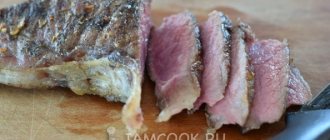How to quickly clean a ready-made tongue?
First, you should make sure that the beef tongue is cooked to the desired degree of readiness. An undercooked delicacy is not very pleasant to the taste, and it is difficult to clean. Just pierce the flesh with a sharp knife. If clear liquid flows out of the hole, the product is ready. If the liquid is cloudy, the element needs to be cooked a little more. The absence of liquid indicates that the workpiece is overexposed or was initially of poor quality.
Boiled beef tongue should be cleaned immediately, while still hot. If you wait until it cools down, the surface layer will have to be torn off in parts, spending a lot of time and nerves.
- Just place the product removed from boiling water into cold water for 1-2 minutes. Then it will be easier to clean, and it won’t burn your hands.
- At the root of the tongue we look for an area with loose skin or make an incision. We pull the fabric, removing it towards the tip of the product. If the tongue is boiled correctly and until tender, the skin will come off without any problems.
- If difficulties arise while removing the surface layer, there is no need to pull the skin too much; it is better to pry it with a knife in problem areas.
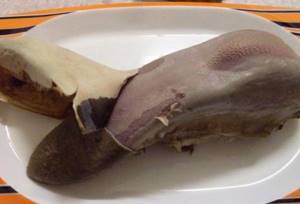
Despite the delicate taste of the delicacy and low fat content, consuming it too often or in large quantities is highly discouraged. An increased content of a number of components can lead to excessive stress on the kidneys. This is fraught with negative consequences, especially for older people.
Unfortunately, the naturalness of a product today is not an indicator of its quality. By purchasing beef tongue at a spontaneous farmers' market, you can get poisoning and even more serious illnesses. Despite such a long processing of the offal, there are no guarantees of its safety. Potential risks can only be reduced by purchasing products in specialized stores and butcher shops. In this case, you should make sure that there is a certificate for the product and a seal confirming its quality on the component itself.
How to cook beef tongue
The tongue is soaked in cold water for an hour, or at least 30 minutes, so that it can be easily cleaned. There may be mucus, blood or dirt left on it - all this needs to be carefully scraped off with a knife, and then washed with cold running water.
When cooking meat, it is recommended to put it in cold water so that all excess is separated in the form of scale, but experts suggest immersing the tongue in boiling water, cooking for about 15 minutes, and only then draining the water - this way it will be softer and more tender. Then the tongue is again placed in clean boiling water and cooked until tender: the cooking time can vary from 2 to 4 hours - it depends on the quality of the product. Of course, the tongue of a small young bull will cook much faster than the tongue of a large mature animal. During the cooking process, you can check the readiness: pull the tongue onto a plate and pierce it with a fork - the juice released from the finished tongue will be clear. If the juice is cloudy, you need to cook more.
The broth is salted almost at the end of cooking - if you do this at the beginning, the tongue will be tougher; add root vegetables (carrots, parsley), peppercorns and bay leaves. The finished tongue should be placed in cold water for a couple of minutes to make it easier to clean. You can salt and season the already peeled tongue so that it better “takes” the salt and spices: it is again placed in the broth and cooked for another 10-15 minutes; then the broth can be useful for making aspic or soup, but the root vegetables must be fresh. Cooked tongue is stored in the refrigerator, like sausage.
For women
Women who are concerned about the condition of their skin and hair
, can include in their menu dishes with beef tongue, which it is advisable to eat boiled.
Thanks to such food, the deficiency of B vitamins is compensated, which has a positive effect on a woman’s hair, skin and well-being. Migraines and insomnia, which often plague women, recede thanks to vitamin PP.
The diet will remove the pips on the tongue
Review your diet. Reduce the amount of sour, spicy, very hot foods to a minimum, all this will only develop and increase your size. During treatment, switch to softer foods that will not injure your tongue. You can temporarily switch to pureed foods and other foods that are soft in consistency.
Prefer dietary food; it will not act as an irritant in any way. During treatment, get into the habit of not drinking carbonated water at all times, replacing it with still mineral water. Not only your tongue, but also your stomach will thank you for this. You can drink non-acidic compote, fresh juice or not hot tea.
The treatment will be effective. You just need to make some effort and take care of your health. The pip is being treated!
Potential dangers and contraindications
The benefits of this product are beyond doubt, but excessive consumption can be harmful to health. Since the offal contains a large amount of fat, overeating it can negatively affect the kidneys
.
Elderly people should not rely on the product
in order not to destroy your immunity. Those losing weight should also be careful when eating their tongue so as not to provoke health problems.
There is a possibility of individual intolerance to the component
, therefore, when trying it for the first time, you need to limit yourself to a small amount.
Harm from eating offal is possible when hormones and antibiotics are introduced into the cow. Because of this, it is imperative to purchase goods from trusted places.
You can reduce the harm of the product by removing the skin before cooking.
On the pages of our website you will also find out! How to properly prepare a dietary product and are there any contraindications to its use?
What beneficial properties do chicken eggs have and why should they be included in your diet? Read.
Is it healthy to eat cottage cheese for breakfast? You will learn everything about this useful product by visiting our page: .
Cleaning
Boiled offal
The process of cleaning boiled pork tongue can be divided into several stages.
Place a pot of water on the fire and wait until the liquid boils. Place the pre-treated pork tongue into boiling water and wait until the liquid boils again. When the foam appears, it should be carefully collected. After the water boils a second time, the fire in the burner is reduced to the minimum value. At this stage, it is recommended to add spices, such as bay leaves and peppercorns. Salt the meat after 30 minutes from the moment it boils. The offal should be cooked for 1.5-2 hours until it becomes soft. You can check its readiness by piercing the pulp with a fork. If this cutlery fits freely into the meat, then it is ready. Please note that it is not recommended to overcook the pork tongue, since if it is cooked for too long, it can become very tough and lose all its beneficial properties. When the meat is ready, remove it from the pan and place it in a container of cold water for a few minutes.
This little trick makes it easy to separate the film from the pulp. Using a sharp knife, pry off the film and quickly remove it before the meat has cooled. Hold the offal by the base with one hand and carefully remove the skin with the other. Try to very quickly pull the skin to the tip of the offal.
Many housewives recommend removing the film when the boiled pork tongue is under running cold water. The water jet should be directed so that it hits the area between the film being removed and the still uncleaned offal. This will allow you to quickly and easily remove unnecessary skin, and also avoid scalding your hands, since the process of removing the skin must be done while the meat is still hot. If it gets too cold, then you won't be able to separate the skin without damaging the flesh.
Do not try to remove all the skin at once - you can carry out this process gradually. To do this, make longitudinal shallow cuts across the entire surface of the pork tongue. In this case, you will remove the film in small pieces.
If you notice that the film is constantly tearing, and you have difficulty separating the flesh from the skin, it means that the pork tongue is not cooked enough. Put it back into the broth and simmer for some more time. A well-boiled offal will be very easy to separate from the skin.
Many housewives recommend putting cleaned pork tongue into broth with spices and boiling it for another 15–20 minutes. This broth should be well salted. This little trick will allow you to get incredibly tender, aromatic and tasty meat, which can be served as a cold appetizer, decorated with herbs.
Raw tongue
Despite the fact that it is much easier to clean a boiled pork tongue than a raw one, in some cases this cleaning procedure will not work, especially if you want to cook roast or stewed tongue. To quickly remove the skin from a pork tongue, you need to follow a certain sequence of actions.
- Boil water in a saucepan and place the pre-treated tongue in it. It should boil for 2-3 minutes.
- After the specified time, the offal is removed from the boiling water and placed in a container with cold water. The meat should lie in this water for a minute or two.
- Pry the film with a sharp knife and gradually remove it.
Some housewives also recommend lightly freezing the pork tongue so that the film comes off easily and quickly. In this case, you should not pre-soak the meat in water - just rinse it thoroughly under running water.
- Place the pork tongue in a plastic bag and place it in the freezer for a short period of time. The meat should not completely freeze, but only slightly “grab” the top layer.
- Using a thin-pointed knife, pry up the skin and carefully separate it from the pulp. Do a similar procedure, moving in a spiral: this will avoid the risk of tearing the skin.
To prevent the pork tongue from slipping out of your hands when you try to peel it off the skin, hold it by the tip and wrap it in a paper towel.
You can learn how to clean a pork tongue from the following video.
How to prepare offal for cooking?
The meat will turn out tender, juicy and aromatic only if it is properly pre-processed. Regardless of whether you plan to boil pork tongue or beef tongue, you need to take into account the following points:
- If you clean the component before cooking, there is a risk of ruining it beyond repair. Firstly, cleaning will take a lot of time, because... the skin will come off reluctantly. Secondly, a significant amount of the edible part will definitely be removed along with it. Finally, such a protective film retains moisture, making the dish juicy.
- But all excess meat and fat should be cut off. Their presence increases the calorie content of the broth, especially if it is pork tongue. Because of this, the dish turns out to be too rich and even greasy.
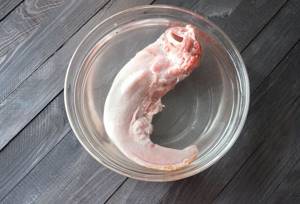
- Even if the offal is purchased in a good store and has obviously been pre-treated, it should be washed and scrubbed with a brush.
- It is worth considering that the tongue cooks for several hours, so you will have to add water during the process. To do this, you should stock up on boiled water; you should not use tap liquid or drinking water.
When planning to boil pork tongue, you should consider using a slow cooker. It makes the offal especially tasty. But for beef preparation, the traditional option is better - in a pan.
How to Store Raw Beef Tongue
It is very important to know how long beef tongue can be stored in one form or another, because this product is for real delicacies.
Before storing fresh beef tongue in the refrigerator, it must be wrapped in cling film, paper or a plastic bag, or better yet, placed in an airtight food container.
No more than 1 day - that’s how long this offal can be stored. You can significantly extend the shelf life of beef tongue by placing it in the freezer.
Up to 8 weeks is how long beef tongue can be stored in an old-style freezer. But in a modern one, with a temperature of 18°C and a No frost system, it can last 6-8 months.
You can first divide it into portions, since you can defrost and cook it several times. In this case, the beef tongue should be wrapped in cling film or placed in a plastic container.
The tongue should be rinsed well under water to remove mucus, blood and other contaminants (if any). Bring the water to a boil and dip your tongue into it. This is a simple procedure to preserve the richness of the tongue. Bring the water to a boil.
For men
Why does the skin need to exfoliate?
Our skin is not only our largest organ, but also one of our smartest. For example, it has the ability to self-renew, and the skin actively uses this ability. The cycle of complete renewal of the stratum corneum of the epidermis takes on average 28 days.
Why do we need exfoliation if the skin does it on its own? We answer. The fact is that there are several factors that inhibit the process of biological “dumping” of dead cells:
- increased skin greasiness;
- dehydration;
- mature age.
So you need to exfoliate your skin regularly, every 7-10 days. We tell you how to do it correctly.
You can stimulate the process of cellular renewal of the skin using homemade cosmetics
There are two ways to exfoliate your skin at home:
- scrub, that is, special products based on abrasive particles that literally scrape off dead cells from the surface of the epidermis. Frequency of use: 1–2 times a week.
- using products containing small amounts that destroy the connections between the cells of the stratum corneum.
We recommend reading:
- What is the difference between peeling and scrub?
- Facial peeling at home
- Exfoliating face mask
Pip – diagnosis or harmless pimple
The opinion of doctors about the reasons why a pip appears on the tongue does not coincide with the opinion of people far from medicine. The object of folk omens is a rather serious inflammation of the oral cavity, which has an infectious or traumatic origin. Glossitis is the official diagnosis.
Glossitis can easily be confused with stomatitis of the oral cavity, but an experienced specialist will differentiate the diagnosis based on the specific primary location of the inflammation and find out the cause of the appearance of a pip on the tongue.
Primary localization
The target of glossitis is always the tongue, an organ consisting entirely of soft tissue. Its main segments:
- root – 1/3 part;
- body – 2/3 parts;
- back - surface facing the sky;
- bridle.
The organ is covered on top by a mucous membrane with stratified epithelium. On the back, tip and sides of the organ, the epithelial lining forms special tubercles - taste buds, thanks to which a person distinguishes the taste, temperature and consistency of food.
Pip appears when the inflammatory process develops specifically on the papillae. Moreover, its primary localization always affects the area of taste buds. In the future, the inflammation can spread to other parts of the oral cavity, at which point the disease is difficult to distinguish from stomatitis.
Usually glossitis begins with a small pimple or ulcers that appear on the tongue. Less commonly, pathology manifests itself as color and structural changes in the epithelium.
Types of glossitis
The disease occurs in acute or chronic form. In order to get rid of the pip on the tongue in a timely manner, you need to study the “enemy” in detail. In medicine, there are 9 types of glossitis:
Catarrhal. The inflammatory process develops due to the penetration of infection through microcracks. Manifestations: minor damage, swelling, hyperemia. Exfoliative or “geographic tongue”. It manifests itself as color and structural changes in the area of the back and end of the tongue. If you look at the photo, you can see that the lesions actually look like a map of the hemispheres. Exfoliative glossitis is an alarming signal indicating hematological diseases, gastrointestinal disorders, neuroendocrine pathologies, and metabolic failures. Allergic reactions also lead to “artistic coloring”.
Diamond type. A geometrically shaped area (rhombus or square) with atrophied taste buds forms on the midline of the tongue. There are smooth, lumpy or papillomatous forms of the disease. It is provoked by fungal infections, smoking, and gastroenterological problems.
The candidiasis type of disease is a fungal infection of the back and tip of the tongue, manifested by a white coating. The cause is poor immunity, disruption of microflora in the mouth.
Atrophic appearance. A specific sign of this form of pathology is an unnaturally smooth red tongue. Other signs: group ulcers with severe pain, unpleasant odor. Sometimes the disease signals HIV infection, gonorrhea, or neoplasm.
Folded shape. Multidirectional folds/furrows form on the surface of the tongue. Initially, this pathology is an anatomical feature, but the folded structure is a favorable environment for the spread of pathogenic microflora. Villous tip. Almost from the very tip, the tongue is covered with filiform papillae elongated to 3 mm. Due to their brownish color and horny structure, they look like coarse hairs. This is a rare type of glossitis that exclusively affects men. The exact cause of the strange changes in the papillae has not been established.
Ulcerative form. Ulcerative glossitis often develops as a result of dental problems. This pip (see photo) looks like small ulcers on the tongue; treatment requires eliminating the root cause.
Phlegmonous/deep glossitis is an extremely aggressive form of the disease that should be treated under strict medical supervision. The lesion instantly spreads to deep tissues, and under unfavorable conditions it quickly reaches the neck and chin. Manifestations: abscess, temperature up to 39 °C, enlarged and painful cervical lymph nodes, in advanced situations - phlegmon.
Glossitis is not so harmless. They arise both as independent diseases and as complications of chronic pathologies of other systems, and cause the patient a lot of unpleasant sensations.
How to treat the problem?
Both medications and folk remedies can be used for treatment. Medicines are usually prescribed by a doctor, indicating the dose and duration of treatment. The following remedies may be indicated:
- Nystatin. An antifungal drug used for thrush. The product is applied to a cotton swab, which is used for spot treatment of rashes. In addition, it can be used to remove plaque from the entire oral cavity. Such manipulations can be carried out 3-4 times a day. The drug is not intended for internal use. Treatment should be continued until the symptoms disappear completely.
- Fungizone. The finished solution is used for local treatment or rinsing the mouth. The drug has many side effects and various contraindications, therefore it is prohibited to use it without the knowledge of a doctor. Can be used for stomatitis and thrush.
- Sodium tetraborate. The drug is used using the classic method for rinsing or treating the mouth with cotton wool. The procedures are repeated three times a day until recovery. Used for thrush and stomatitis.
In other cases, specific treatment measures are prescribed. If herpes led to acne, Interferon and treatment of inflammation with Acyclovir may be required. The dose and duration of treatment is determined by the doctor. For allergies, Zyrtec may be indicated, as well as complete absence of contact with the allergen.
If the rash is a consequence of damaged internal organs, you first need an examination, and then eliminate the underlying problem. If pimples are the result of mechanical damage, they can go away on their own, and without additional treatment.
Along with medications, folk remedies can also be used. Their effect may not be so strong, but there will be significantly fewer contraindications and side effects. You can use them for children. But, despite all the safety, it is also worth consulting a doctor before use.
- Toothpaste. It can be effective if dirt gets on the tongue and causes rashes. A simple toothpaste can eliminate swelling and reduce pain. It is necessary to treat the inflammation with the composition using a cotton swab. Repeat 5-7 times a day.
- Rinse. If the pimple is noticeable on the edge or root of the tongue, a very simple method can help. Dissolve two tablespoons of water in a glass of water and rinse your mouth with the solution. You can also soak a cotton pad in this liquid and use it to treat the affected areas. You can also prepare a decoction of chamomile or St. John's wort by pouring a glass of boiling water over two tablespoons of flowers. You need to leave for an hour and strain. After this, the decoction will be ready for use. Rinse your mouth every couple of hours.
- Peach kernel oil. This effective remedy can easily be purchased at a pharmacy. Soak a cotton swab in it and treat acne. Repeat up to four times a day.
- Zelenka. This is the most famous antiseptic that can be used to treat rashes on the mucous membrane. Acts quickly and gently. Dip a cotton swab in the brilliant green and hold it there for about a few seconds. This should be repeated every three hours. If you have fillings in your teeth, it is better to choose another remedy, as brilliant green can change their color.
- Aloe. It is enough to take a little of the pulp of this plant and apply it to the swelling. Secure with a cotton pad and leave for 20-30 minutes. Repeat several times a day until the unpleasant symptoms disappear.
However, remember that the presence of pimples on the tongue is not always such a harmless symptom. Therefore, it is always better to consult a specialist and listen to his advice. Proper oral hygiene and avoidance of factors that can injure the tongue are also important. If a painful rash appears on the tongue, you need to provide the oral cavity with a state of rest.
Step-by-step instructions on how to boil and peel pork tongue:
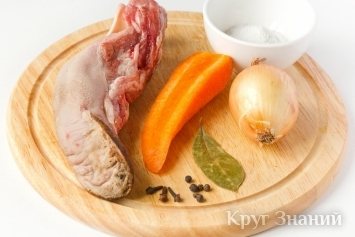
Prepare pork tongue (weighing about 300 g), carrots (0.5 pcs.), onions (1 pc.), bay leaf (1 pc.), black peppercorns (6 pcs.), cloves (3 pcs.), salt (0.75 tsp), water.
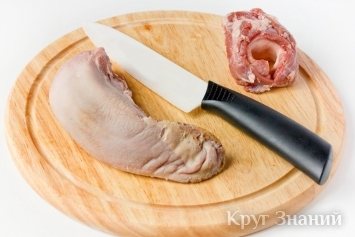
Wash the pork tongue thoroughly, clean the remaining dirt with a sharp knife, scrape off the coarse coating, and cut off the larynx.
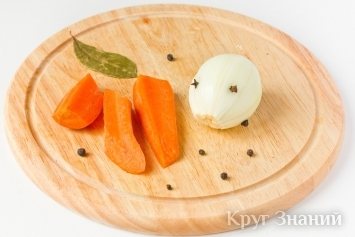
We clean the carrots and onions. Cut the carrots into large pieces, cut the onion into 6-8 parts, without cutting all the way from the tail side. You need to stick a clove into the onion.
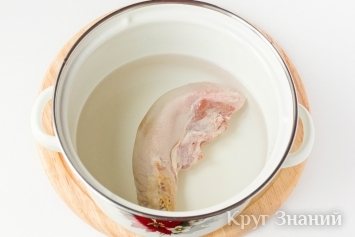
Place the prepared tongue in a small saucepan and fill it with cold boiled water so that it covers the tongue by 1 cm.
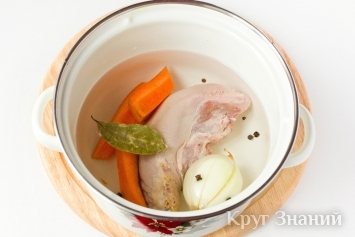
Add onions, carrots, bay leaves, and black peppercorns to the tongue. Place on the stove, bring to a boil over high heat under the lid, then reduce the heat to low and cook the tongue. After 30 minutes, salt the water and remove the bay leaf. We continue to cook the tongue.
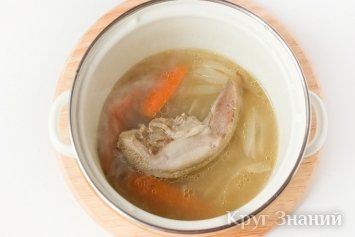
After 1.5 hours, the pork tongue is ready! If the tongue is larger, the cooking time increases.
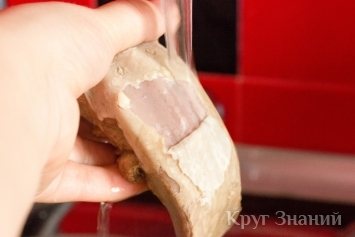
We take it out, check its readiness with a fork - the flowing juice should be clear, and the tongue itself should be soft. We clean it under cold running water - the skin comes off easily! You need to clean your tongue while it’s hot, immediately after cooking, and under running cold water! This is an important point at which the skin will be removed easily and almost effortlessly!
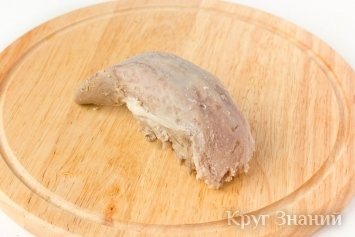
If you cannot clean the entire tongue under running water, use a knife to clean it on a cutting board, lightly scraping the skin.
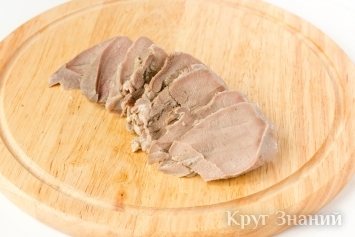
We use the finished peeled tongue for its intended purpose - we serve it as a hot or cold meat appetizer, we use it to prepare salads, sandwiches and other dishes!
Fresh pork tongue has a uniform color when cut. The larger the tongue, the longer it will take to cook! In the same way, you can boil and peel beef and veal tongue.
Pork tongue is truly a delicacy. It is served as an independent cold appetizer, and is also included in various salads. If this product is prepared correctly, it will be soft, tender and have an incredible taste.
In the process of preparing such a dish, the question arises of how to properly clean the pork tongue, because it is necessary to do this not only quickly, but also in such a way that after removing the film, as much pulp as possible remains and it retains its aesthetic appearance. It should look very neat if the pork tongue is served as a separate dish.
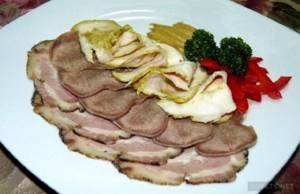
How to properly prepare, skin and boil beef and pork tongues
It is impossible to say with complete certainty when this offal became desirable on the table and, moreover, scarce and high-status, but it is known for sure that peasants were forbidden to eat it; it was the privilege exclusively of gentlemen and people from high society. Nowadays, this product is also an infrequent guest on the table, and traditionally dishes from it appear on the table on holidays.
A lot of different dishes are prepared from beef tongue; it is used in first courses instead of regular meat; with its addition, salads are made, main courses and various gourmet snacks are prepared. Ready-made smoked, salted and marinated delicacies in various dressings are sold in store windows. But even without adding other ingredients, it is very tasty in itself and can be consumed as an independent product due to its rich, original taste. Beautifully chopped boiled tongue, neatly laid out on a plate with vegetables and herbs, will decorate any table.
Contents of the material
Calorie content and composition of beef tongue
Beef tongue is valued not only for its high taste, it also has a unique composition. The product contains a balanced composition of protein, microelements, including sodium, potassium, iron, zinc and others, necessary for excellent well-being and full development of a person.
Depending on the methods of heat treatment, its calorie content changes:
- 100 grams of raw meat is approximately 173 kcal.
- Boiled will contain only 90 kcal.
- The calorie content of the stewed product will be 183 kcal.
Therefore, on a diet, it is better to eat it after cooking as a separate dish or by adding a light side dish of raw vegetables, and for heavy physical labor or intense training, it is recommended to stew it with the addition of healthy cereals.
We also recommend reading:
Selection of quality raw materials
No cooking method can correct the quality and taste of a stale, stale product, especially one with a “smell.” All the beneficial properties of the tongue are inherent only in fresh, high-quality meat. This is a product without signs of weathering, without spots and color unusual for meat - this is what the tongue should look like. By the way, the spots may be from the color of the animal’s tongue, but they cannot be confused with rottenness and signs of spoilage of the product.
An adult animal will have a very large tongue, but this may also be an indicator of old age. It will take a long time to cook.
More nutrients are found in the meat of an adult, but not an old animal. Veal, pork and lamb tongues are inferior in their benefits to beef, but are an alternative substitute due to their greater availability in stores and due to their lower cost.
Useful properties of the product
Due to its rich composition, the condition of the skin improves, the immune system is strengthened, and most importantly, due to the high content of complete protein, this product is almost irreplaceable in the diet of children and pregnant women. Protein is responsible for building the muscle corset and is the main building material for a growing body. Lack of protein leads to muscular dystrophy and developmental disorders of the child's body. With a lack of protein in the diet, the skin, hair, and hormonal structure suffer.
Beef tongue is useful for anemia and during recovery after illness and surgery, as it contains a lot of iron.
There is an opinion that the tongue takes a long time to prepare. This is true if you cook it in the usual way. But almost every family has a multicooker and a pressure cooker, which reduces the need to control the cooking process to a minimum; the main thing is to choose the right mode. In a multicooker, the “stew” mode is suitable, but in a pressure cooker it’s even easier, just pour a little water into the bowl, put your tongue in and turn it on to maximum mode. However, the list of beneficial properties of the tongue outweighs the cost and time spent on preparation, since the product:
- Contains a lot of minerals, including vitamins B, PP, zinc, which is rare in meat in such quantities. Iodine, potassium, phosphorus and iron are responsible for the production of hormones and amino acids.
- Promotes the body's production of insulin, which is important for diabetics.
- Responsible for tissue regeneration in postoperative patients.
- Makes the skin elastic.
- Does not contain connective tissue, making it easier to absorb for patients with gastritis and ulcers.
- Reduces blood cholesterol.
- It is an excellent product when dieting for weight loss, as it contains a lot of protein and little fat.
How to properly cook and clean beef tongue
There are several ways to cook a tongue.
First way
If the tongue is cooked for slicing, then pre-boiled water is poured into the pan, the tongue is put in, everything is brought to a boil and cooked over reduced heat for 10-15 minutes. Then the water in which the tongue was boiled is drained, clean boiling water is poured in, and cooked until ready. This is done so that, along with foam, unpleasant odors and dirt located on the rough surface of the hard skin of the product are removed from the tongue. During cooking, and the cooking time, depending on the weight and age of the animal, can reach up to 3 hours, you should monitor the water level so that it does not boil away, and add boiling water if necessary.
You can add carrots, onions, celery roots and stalks, dill and other seasonings to taste half an hour before the end of cooking. By adding vegetables to the broth, you can enrich the aroma and texture of the finished product. In addition to carrots and onions, it is permissible to add bay leaves, peppercorns, cumin, cumin and other aromatic spices. Salt should be added shortly before the end of cooking the offal.
The readiness of the tongue is checked with a knife. You should pierce the tip and see what juice comes out of the puncture. If it is cloudy, the tongue must be cooked for some more time. If a clear transparent liquid is released, then the tongue should be removed from the broth. To peel the beef tongue, the product is immediately immersed hot in very cool water, possibly with ice added, for a few minutes to make it easier to remove the skin.
How much to cook veal, lamb or pork tongue and how to clean it depends on their size and age of the animal; if they are small, they can be cooked in half an hour to an hour. All tongues are cleaned the same way, by pre-cooling and removing the rough skin, but very small and young ones do not need to be cleaned, this will not affect the taste.
Calorie content and chemical composition
Depending on the age and living conditions of the animal, the calorie content of boiled pig tongue is more than 200 kcal per 100 g of finished product, with approximately the same amount of fat and protein (16 g each). As for carbohydrates, they are either completely absent here or their amount does not exceed 1 g, making this delicacy suitable for use in various diets.
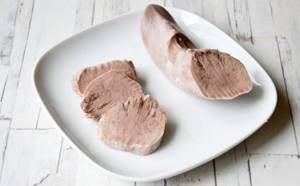
At the same time, with such nutritional value, its vitamin and mineral composition cannot be called poor, because among the useful components there are:
- vitamins - group B (B1–B3, B6, B9, B12), E, PP;
- microelements - iron, cobalt, manganese;
- macroelements - phosphorus, magnesium, potassium, sodium, calcium.
On average, one boiled pork tongue weighs about 300 g, so if you need to accurately calculate all the calories, it is recommended to proceed from this value.
How to store boiled beef tongue
Before storing the boiled beef tongue on the refrigerator shelf, cool it.
- You can keep this dish without freezing for about two days.
- The cooked dish is wrapped in foil or paper and placed in a plastic container with a tight lid.
- This product is able to absorb environmental odors very well, so it is kept separately, hermetically sealed.
You can also store boiled tongue frozen..
After cooking, it needs to be cooled and divided into parts so that it is later convenient to defrost only the required amount. This dish cannot be re-frozen.
Storing beef tongue is not at all difficult. If you comply with the necessary conditions, you can always consume this healthy dietary product fresh.
Among meat products, beef tongue is most valued by lovers of gourmet cuisine. It is considered a delicacy due to its delicate structure and original taste.
Its composition is rich in various useful substances, which makes the prepared dishes valuable and nutritious. What are the benefits of beef tongue? Let's find out!
Despite the fairly affordable price, the offal contains a large number of useful substances. If you use it 100 grams. per day, you can provide the body with the daily norm of vitamin B12, as well as protein, while receiving very few calories (100 grams of product contains 173k Cal).

